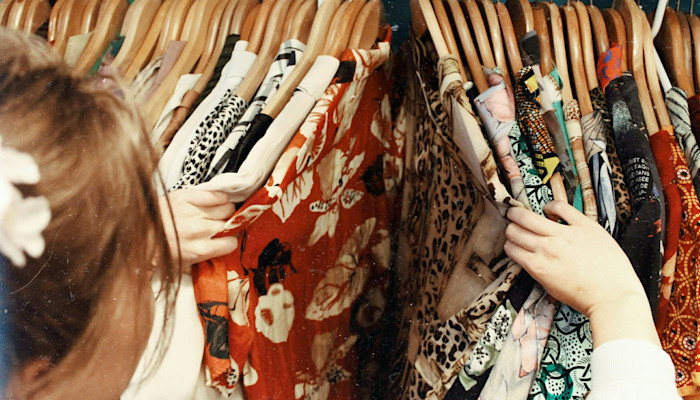Is second-hand the future?
The second-hand market is expected to hit US$64b by 2024, while retail is expected to shrink. What does this mean for the future of the fashion industry, and should you be joining the trend?
Take a look at your wardrobe. How many garments are in there? How many of them did you buy new? How many are second-hand or vintage? How long have you had them for? How much money do you think you’ve spent on clothes in the last year?
Now take a look in the mirror. Are you the kind of person to always want the latest trends? Or does the thought of shopping make you shudder? Are you somewhere in the middle? Do you consider yourself an environmentalist? Do you use a keep cup, reduce your meat consumption and take public transport to reduce your footprint?
Did you know that fashion and the environment are intrinsically linked? You wardrobe has an impact, but you might not know how much.
You can calculate your fashion footprint with a few quick questions using the ThredUp calculator here.

Photo by Becca McHaffie on Unsplash
The global fashion industry is one of the largest polluters in the world, with exorbitant natural resources being poured into garments every day. According to Oxfam, it would take thirteen years to drink the amount of water needed for a single pair of jeans, and in research conducted by McKinsey & Company, it was also discovered that making one kilogram of clothing generates 23kgs of greenhouse gases. As of 2017, the Ellen MacArthur Foundation found that less than one per cent of textiles are recycled into new products.
The fashion industry can’t survive without the environment — it relies on oil, water, soil, livestock, land and natural fibres such as cotton and flax, not to mention all the insects and bees that help pollinate them. However, the environment can’t sustain the industry as it currently operates.
In Australia, on average we purchase 27kgs of clothing per person every year — the global average is 13kgs — and we also send 6000kgs of textiles to landfill every ten minutes. With 63% of all new clothes now being made from petrochemicals, they’re also unable to break down in landfill.
So, where does that leave those of us who love fashion?
That’s where the second-hand market comes to the rescue. The fashion industry is producing about 80 billion garments a year — that’s enough for every person on Earth to have 10 new garments every year. Sadly, 84% of these clothes are ending up in landfill of incinerators. There are still more clothes in existence than we could ever possibly need, so the second-hand market acts as a circuit-breaker to keep clothes in circulation and out of landfill.
US second-hand marketplace ThredUp predicted in 2019 that the second-hand industry would grow to five times its size over the following five years, reaching a value of US$64b by 2024. With the onset of COVID-19, their annual report was tweaked to include the growth of the online marketplace, which is expected to grow by 69 per cent by the end of this year. They also accounted for the experiences of those in lockdown; with a 50 per cent increase in wardrobe decluttering from the 3500 women surveyed, and 88 per cent indicating a positive behavioural or attitude change towards thrifty hobbies such as mending clothes. According to McKinsey & Company, these behavioural adjustments are expected to survive beyond COVID-19. It is now predicted by ThredUp that the second-hand marketplace (including both online and in-person) will be double the size of the fast fashion industry by 2029.

So should you get on board with the second-hand fashion movement?
Yes. Not only is the second-hand market great for the environment, it’s also a great financial choice during an economic crisis that makes fashion more accessible to different budgets. Second-hand platforms such as ThredUp, Depop, Vestiaire Collective, Facebook Marketplace and so on, allow you not only to shop for heavily reduced items, but also sell your pre-loved clothes to earn back some cash on your purchases. Gen Z are leading the way, with 80 per cent of those aged under 24 saying there’s no stigma associated with shopping second-hand, and 40 per cent participating in the second-hand market in 2019. Even Vogue Editor-in-Chief Anna Wintour supports the changing industry, stating we should be “valuing the clothes that [we] own and wearing them again and again”.
Is it all good news?
Sadly not. The second-hand market has a lot of benefits, but it’s not perfect by any stretch of the imagination. Due to the rise of fast fashion over the last century, a lot of the poorer quality garments that we see in the high streets ultimately find their way into our second-hand stores (both online and in physical stores). On top of this, a lot of the unwanted clothes from the global north are shipped off and essentially dumped in the global south (where most of the clothes are made) which damages local textile industries. In some African countries such as Rwanda, Uganda and Tanzania, they’ve been inundated with so many used clothes that they’ve taken steps to ban future imports.

The rise of the second-hand market is also dangerous for garment workers who rely on the constant production of new garments to survive. There are 80 million garment workers in the world, so what will happen to them if fast fashion is overtaken by the second-hand market?
On the surface, it seems the second-hand market will solve a lot of problems. However, the industry also perpetuates inequality between the developed and the developing world. On an environmental level, shopping second-hand is crucial. But on an ethical level, there’s more work that needs to be done to make sure garment workers aren’t left in limbo while the rest of us try to thrift the problem away.
